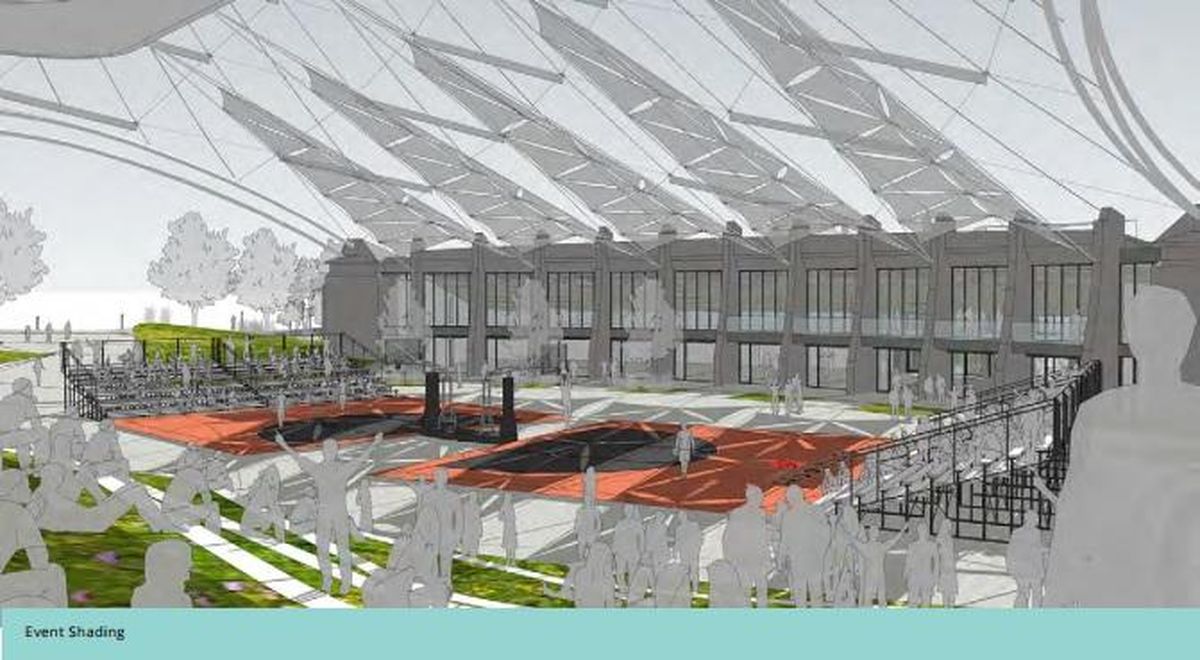U.S. Pavilion plans with temporary shade structure, no permanent cover approved by Spokane park officials

Temporary, sail-like fabric shading and cabana umbrellas will stretch above the new U.S. Pavilion during the summer, according to plans approved this month by the Spokane Park Board.
The designs prepared by a team led by Garco Construction and NAC Architecture are intended to address the concerns raised earlier this year that the new plans didn’t include a cover for the structure, which debuted in Expo ’74 with a canvas, circus tent-like topper that was torn off several years later due to damage from snow and ice. Approval of the $16.5 million construction plan, including the temporary shading, will allow demolition of the existing pavilion to begin next month, with plans for the remodeled building to open about May 2019.
Chris Wright, president of the Spokane Park Board, said members did not discuss the lack of a permanent cover before approving the design team’s work. A 2012 study of the existing uncovered cable netting, which has graced the Spokane skyline for nearly four decades, warned re-sheathing the structure would require designing to current safety load standards, which are much higher than when the federal government gifted the pavilion to Spokane following the world’s fair.
“The idea is to make it removable and storable,” Wright said. “The idea of a permanent cover, it didn’t come up at all, though it has been percolating quite a bit in the community and on the board.”
Designers had estimated that an additional study to determine the load maximum for the netting could cost $500,000 and delay the project at least a year. The cost of covering material was estimated at about $4.5 million and would nix plans to include a viewing platform about 35 feet above the pavilion floor that would allow visitors to look out over the Spokane River.
The kerfuffle over the cover included criticism from Spokane City Council President Ben Stuckart and his colleague, Mike Fagan, who serves as the council’s liaison on the park board. Stuckart argued that a covered pavilion was part of the pitch made to voters to fund the park’s renovation, and was critical of early plans for the structure. The council president has been brought onto the executive team reviewing plans for the $64.3 million-plus renovation of Riverfront Park, and he said this week he’s pleased with the revisions that include temporary shading.
“I think it’s better than it was before,” Stuckart said. “I was worried about event space, and they’ve addressed that.”
The plan calls for cabana-type structures on the eastern edge of the current pavilion’s footprint, which will now include landscaped spaces planners said would have been impossible if the pavilion were permanently covered. During the summer months, when the new pavilion is planned to house Bloomsday, Hoopfest and Pig Out in the Park events, translucent fabric will be tied to the structure’s central mast and anchored to a proposed viewing platform above the administration buildings on the pavilion’s west side. Renderings show stretches of shade reaching across a proposed Hoopfest center court.
The shade features, as proposed in the plans approved by the park board, will cost about $700,000.
Mayor David Condon said he, too, was impressed with the work of the pavilion designers, who he said had to create a design that provided views of the river, created illumination for the center of the park and provided cover from the elements.
“I think the team did an amazing job of balancing those three programs, of light, vista and shelter,” Condon said.
The proposed plan includes illuminated panels, which the team has dubbed “blades,” that would hang from the existing netting structure in a spiral pattern cascading to the floor of the pavilion. Park board members reviewed a prototype created by the design-build team made of frosted acrylic, with a series of light-emitting diodes enabling a rainbow effect of colors.
Builders estimate the illumination blades will cost nearly $2 million.
Garrett Jones, planning and development manager for the Spokane Parks Department, said there are “endless possibilities” for illumination effects because each blade’s dozens of LEDs can be separately programmed.
“We can’t find anything else like this,” Jones said. “We think it will be unique.”
Wright said the team was impressed, but there are still concerns about weight. The team has not determined a final number of blades that would be hung from the netting, which is separate from the supports that actually held the canvas beneath the now-visible netting in the 1970s. There are also concerns about the potential buildup of ice, though Jones said barely any heat is generated by the lights illuminating the panel.
“The design team’s not too concerned about a lot of thaw and freeze,” Jones said. The blades will also hang at a nearly vertical angle, which would prevent the buildup of rain and snow that plagued the old canvas cover, planners said.
Fagan said he still has some concerns about the abundance of glass railings and barriers in the design, which he said would require frequent cleaning and maintenance. But the council member, once skeptical that residents who voted to support the bond paying for the park’s redesign could get behind an uncovered pavilion, said he now believes the public will be awed by what they see in the building’s new design.
“It’s going to be totally different,” Fagan said. “You’re not even going to be able to call it the U.S. Pavilion anymore.”